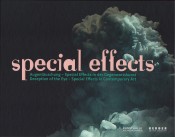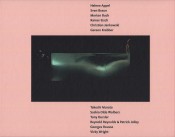Christian Jankowski’s practice pivots, it seems, on deceptive appearances — not least, regarding his role as author. To this end, he enlists all kinds of collaborators: children, politicians, gallerists, entertainers, evangelists, factory workers, and others. His helpers may end up trading roles or speaking each other’s words; performing on camera in absurd costumes; or even assisting the artist without guessing that their contribution is, itself, the work (as in the 1999 video Telemistica, composed solely of TV psychics’ cheerful — and accurate — predictions of the success of Jankowski’s next work).
16mm Mystery, a five-minute feature film starring a single actor, follows suit. Here, though, it’s the artist who’s in costume — disguised as himself. An establishing shot shows us downtown Los Angeles; then Jankowski appears, clad in working gear and bearing the tools of his trade — a 16mm film projector and a fold-up screen. Off he strides through the empty streets, the very image of the upstanding worker-artist: Bonjour, M. Jankowski! Next, though, he sneaks into a dark basement, invoking a newer and darker stereotype: the intruder-disguised-as-maintenance-man. Exiting onto a rooftop, he sets up his kit and begins a screening that (because his fold-up screen faces away from us) we can’t see. But as the film starts, catastrophe strikes. In the shot’s background a colossal glass skyscraper shivers and explodes into a myriad fragments, leaving behind a carcass of twisted metal. Jankowski then packs up and goes, giving no clue to any link between his actions and the disaster that’s just occurred.
That Jankowski’s on-screen role should be so ambiguous is, perversely, an honest gesture, since he both is and isn’t the creator of this enigmatic Hollywood amuse-bouche. The initial concept was his, but 16mm Mystery‘s glossy production, its soundtrack (a slick piece of electronica based on a tension-inducing, heart-rate monitor-style bleep) and its special effect were generated by digital effects virtuosos Greg and Colin Strause, suppliers of (amongst other things) icebergs to Titanic director James Cameron. They, not Jankowski, chose the motif. Since the events of 9/11, they explain, “a falling skyscraper… provokes such a huge emotional reaction” that it seemed the “perfect image to… show the power of film”. First time around, viewers may well be struck by the effect’s mimetic brilliance. On repeated viewing, though, it is the film’s power to evacuate the charged image, to point to a disturbing neutralising of reality via the mediated real of the media, that impresses.
Hollywoodschnee also features both special effects and a masquerade of identity. Individuals employed away from the creative centres of film (including a film festival executive and a finance manager) play at movie stars, sharing their ultimate dreams of cinematic bliss with the camera. As each speaks, a dramatic effect intervenes. A raging fire erupts; a fake gunshot has blood spattering the speaker’s shirt; snow falls inside a cosy interior. The effects elegantly adorn each performer’s utterance, but seem finally to point up another kind of “special effect”: the power of cinema’s clichés and evacuated tropes to bathe any ordinary mortal with the gravitas and charisma of the star.
From Deception of the Eye: Special Effects in Contemporary Art
Wilhelmshaven: Kunsthalle Wilhelmshaven, 2010, pps. 54-55.
Text © Rachel Withers 2010. Images © Christian Jankowski.



